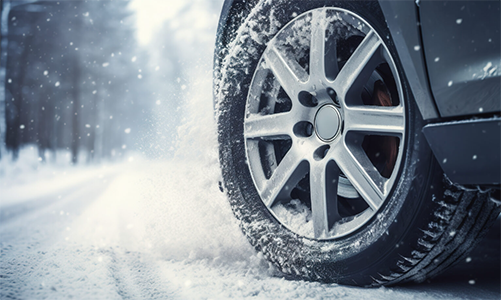||| FROM THE ALASKA BEACON |||
For decades, concerns about automobile pollution have focused on what comes out of the tailpipe. Now, researchers and regulators say, we need to pay more attention to toxic emissions from tires as vehicles roll down the road.
At the top of the list of worries is a chemical called 6PPD, which is added to rubber tires to help them last longer. When tires wear on pavement, 6PPD is released. It reacts with ozone to become a different chemical, 6PPD-q, which can be extremely toxic — so much so that it has been linked to repeated fish kills in Washington state.
The trouble with tires doesn’t stop there. Tires are made primarily of natural rubber and synthetic rubber, but they contain hundreds of other ingredients, often including steel and heavy metals such as copper, lead, cadmium, and zinc.
As car tires wear, the rubber disappears in particles, both bits that can be seen with the naked eye and microparticles. Testing by a British company, Emissions Analytics, found that a car’s tires emit 1 trillion ultrafine particles per kilometer driven — from 5 to 9 pounds of rubber per internal combustion car per year.
And what’s in those particles is a mystery, because tire ingredients are proprietary.
“You’ve got a chemical cocktail in these tires that no one really understands and is kept highly confidential by the tire manufacturers,” said Nick Molden, CEO of Emissions Analytics. “We struggle to think of another consumer product that is so prevalent in the world and used by virtually everyone, where there is so little known of what is in them.”
Regulators have only begun to address the toxic tire problem, though there has been some action on 6PPD.
The chemical was identified by a team of researchers, led by scientists at Washington State University and the University of Washington, who were trying to determine why coho salmon returning to Seattle-area creeks to spawn were dying in large numbers.
“This lethal toxin has no place in any salmon-bearing watershed.” – Joseph L. James, chairman of the Yurok Tribe
Working for the Washington Stormwater Center, the scientists tested some 2,000 substances to determine which one was causing the die-offs, and in 2020 they announced they’d found the culprit: 6PPD.
The Yurok Tribe in Northern California, along with two other West Coast Native American tribes, have petitioned the Environmental Protection Agency to prohibit the chemical. The EPA said it is considering new rules governing the chemical. “We could not sit idle while 6PPD kills the fish that sustain us,” said Joseph L. James, chairman of the Yurok Tribe, in a statement. “This lethal toxin has no place in any salmon-bearing watershed.”
California has begun taking steps to regulate the chemical, last year classifying tires containing it as a “priority product,” which requires manufacturers to search for and test substitutes.
“6PPD plays a crucial role in the safety of tires on California’s roads and, currently, there are no widely available safer alternatives,” said Karl Palmer, a deputy director at the state’s Department of Toxic Substances Control. “For this reason, our framework is ideally suited for identifying alternatives to 6PPD that ensure the continued safety of tires on California’s roads while protecting California’s fish populations and the communities that rely on them.”
The U.S. Tire Manufacturers Association says it has mobilized a consortium of 16 tire manufacturers to carry out an analysis of alternatives. Anne Forristall Luke, USTMA president and CEO, said it “will yield the most effective and exhaustive review possible of whether a safer alternative to 6PPD in tires currently exists.”
Molden, however, said there is a catch. “If they don’t investigate, they aren’t allowed to sell in the state of California,” he said. “If they investigate and don’t find an alternative, they can go on selling. They don’t have to find a substitute. And today there is no alternative to 6PPD.”
California is also studying a request by the California Stormwater Quality Association to classify tires containing zinc, a heavy metal, as a priority product, requiring manufacturers to search for an alternative. Zinc is used in the vulcanization process to increase the strength of the rubber.
When it comes to tire particles, though, there hasn’t been any action, even as the problem worsens with the proliferation of electric cars. Because of their quicker acceleration and greater torque, electric vehicles wear out tires faster and emit an estimated 20% more tire particles than the average gas-powered car.
**If you are reading theOrcasonian for free, thank your fellow islanders. If you would like to support theOrcasonian CLICK HERE to set your modestly-priced, voluntary subscription. Otherwise, no worries; we’re happy to share with you.**









I urge everyone to read the rest of the story, though brace yourself; the news is bad.
“More than three quarters of microplastics entering the ocean come from the synthetic rubber in tires.”
“Because of their quicker acceleration and greater torque, electric vehicles wear out tires faster and emit an estimated 20% more tire particles than the average gas-powered car.”
“…tire and brake emissions in Anaheim accounted for 30% of PM2.5, a small-particulate air pollutant, while exhaust emissions accounted for 19%. Tests by Emissions Analytics have found that tires produce up to 2,000 times as much particle pollution by mass as tailpipes.”
Hmmm. Another down side of electric vehicles comes to light… not to mention the elephant in the room – lithium ion batteries. The tire particulates are greatly concerning because the county/Public Works solution to storm water in our ‘urban growth area’ of Eastsound and surround is to pipe storm water underground by tearing up existing roads, then treat the runoff from up-slope with some chemical or other and dump all of that through a huge outflow pipe directly into Fishing Bay, which doesn’t flush. After our dry summers when it starts raining in earnest, that is the time to monitor what we are dumping into the Bay and Crescent Beach bay. Is anyone from the County or Pub. Works doing that – taking water samples from first big rains? Horseshoe Hwy hugs the shoreline in a lot of places. All of this is concerning and seems poorly thought.
So now that we know… what are solutions? I’m for the idea that has been suggested by many others for many decades…. that we stop deforesting and destroying Eastsound Swale and our watershed, dial the densities way back by making the Urban Growth Area a LAMIRD and the villages, Hamlets – and let riparian wetlands do their job. Natural filtration from trees seems like the kinder gentler way to deal with even our modern lifestyle. The simple answers are to stop deforestation and consume less.
Even with this new data on pollution from tires and ongoing concerns about lithium mining and recycling, it seems clear that EVs are less damaging to the environment than ICE vehicles, at least where the electricity for charging comes from renewable sources.
However, the problem is not which technology makes a car move, it’s the existence of the car in the first place. Individual automobiles are a deeply damaging luxury item that the US foolishly embraced a century ago as our global fossil fuel spree began in earnest. As a result, much of our built environment is completely car-centric; even the little village of Eastsound is primarily devoted to accommodating cars, not people walking or biking.
At the moment, since we are stuck with the infrastructure that we currently have, it seems the best we can do is to diversify transportation options going forward. By prioritizing walking, biking, buses, (non-bullet) trains AND by encouraging walkable communities, I believe we can gradually reduce the number of cars of all types. Obviously there is no one-size-fits-all approach that will work in every community; in wide open rural areas with sparse populations private automobiles make better sense than buses, trains only make sense along routes that have sufficient ridership, etc. But if we commit to creating and encouraging walkable communities and better-linked diversified transportation systems, I think we will be moving in a better direction.
Well said, Ken. If major cities in this country were connected by rail, as in Europe, both passenger and freight service would be much more energy efficient. Locally, we need more transportation efficiency in in terms of car-shares (as OPAL is beginning to do), public/private shuttle service (as Nantucket and Martha’s Vineyard have done) which will be necessary for any viable passenger ferry plan, and, most of all, more homes located in denser, walkable village areas. The County needs to begin to take seriously the idea of an Eastsound walkable village and providing necessary footpaths and easements. “Access by Proximity” is the key.